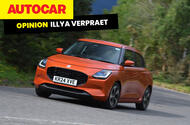The business case is tough for affordable cars, but we’re glad some car makers still serious about them
For the past few years, I’ve compiled a feature looking at the year’s road test stats in one of the Christmas double issues of our magazine.
It was quite striking in 2023 how the average star rating had gone down from four to 3.5, and there were no five-star verdicts. Not a great vintage, then, 2023.
When 2024 immediately started serving up some really good cars (Dacia Duster, Hyundai Ioniq 5 N, Morgan Plus Four, Skoda in general), I started to wonder whether the tide had turned, or if I was going soft.
So I was quite pleased to join editor and Car of the Year juror Mark Tisshaw at Tannistest in Denmark. This is an event organised by the Car of the Year committee to gather together as many of the year’s significant cars in one place to test them back to back. That’s why a lot of our recent first drives were in ‘North Jutland’.
It did restore my faith in mediocrity. By the end of the two days I was there, I had driven so many slightly forgettable crossovers that they all started to blend into one.
Many of them are perfectly decent cars that you would be quite pleased with at the rental desk, but they don’t do anything their hatchback counterparts or technically similar platform-mates don’t. Which begs the question: are they really necessary?
Actually they are, because they enable the really good stuff to shine all the brighter – and let there be no doubt that there are some really clever and delightful cars coming onto the market right now. You just need a grey background for the stars to shine.
The Renault 5 is brilliant, and not just because of the bright colours it’s offered in. I won’t repeat Tisshaw’s review, but what I particularly love is that it manages to be cheaper than the Mini Cooper E without feeling it.
While many manufacturers are just using a slab of screen as an excuse for interior design, the 5 beautifully melds retro and modern, yet it still has all the tech on board you might want. In a way, the Dacia Duster does a similar thing at an even lower price point.
After a morning of driving electric and hybrid cars, the Suzuki Swift – which I’d missed when it came through the Autocar office earlier this year – provided the perfect detox.
It was one of only three cars with a manual gearbox at Tannistest, which is a bit depressing in itself, but I wasn’t thinking about that as I redlined the happy three-pot through several gears, then heel-toed back down the gears for an approaching corner.
It’s not the most sophisticated vehicle ever to grace a showroom, but I had more fun flinging this 945kg hatchback around than I did in the Lotus Emeya. With its sub-tonne kerb weight, the Swift arguably leans closer to the Lotus ethos than the big electric saloon, which is very fast and very composed but could be any premium saloon coming out of China.
What’s doubly encouraging is that the fire seems to be coming from the affordable end of the market, while some of the premium players give the impression they’re coasting.
The business case remains tough for affordable cars, but it’s good to see that some car makers are still putting serious effort into them. And pour one out too for all the other cars providing the necessary context.







